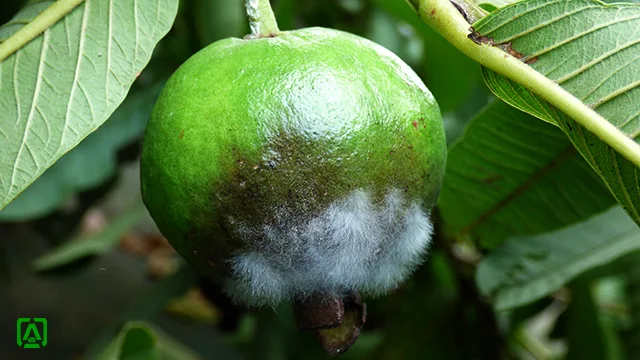Phytophthora fruit rot
Host: Guava (Psidium guajava) L.
Pathogens: Phytophthora parasitica Dastur, Phytophthora nicotianae var. parasitica
Pathogens: Phytophthora parasitica Dastur, Phytophthora nicotianae var. parasitica
Distribution
Phytophthora fruit rot was first reported from Pusa, Bihar by Miter in 1929. Since then, the disease has been reported from Andhra Pradesh, Karnataka, Tamil Nadu, Maharashtra, Punjab, Rajasthan and Uttar Pradesh. Ko et al. reported this disease from an orchard of Waiakea-Uka from the island of Hawaii in 1982. Pervez et al., reported an outbreak of this disease in Bangladesh during 2018.
The disease in Prevalent in the wet-rainy season (during July to September). The fruits, which are hanging near the ground or with dense foliage lacking proper ventilation are mostly affected. The disease also appears during storage.
The disease in Prevalent in the wet-rainy season (during July to September). The fruits, which are hanging near the ground or with dense foliage lacking proper ventilation are mostly affected. The disease also appears during storage.
Symptoms
 |
| Phytophthora start growing at stylar region of guava |
 |
| Phytophthora covering entire surface of guava |
The fruit infected with Phytophthora rot appear as grayish brown and water-soaked with grayish black center. Disease appears in the form of white cottony growth of mycelium over the fruit. The symptoms appear first on the apex of the fruit (stylar end) and grow towards the pedicel. Under a high humid atmosphere entire the fruit surface is covered by the mycelial growth within 2 to 3 days. The skin of affected fruit becomes soft and retains normal shape and size unless invaded by secondary pathogens. The pedicel of infected guava fruit also becomes soft, eventually fruit drop-off.
Pathogen
Fruit rot of guava is caused by Phytophthora parasitica Dastur, Phytophthora nicotianae var. parasitica. Phytophthora parasitica is homothallic and produces oospores in single culture.
Control measures
- Avoid dense plantation of the plants, as it retains high humidity, which favors the disease incidence and disease severity.
- Provide support to the branches hanging down near the ground.
- Spray 0.2 % Zineb or 10 ppm aureofungin.
- Copper oxychloride inhibits the conidial germination of the pathogen, however, it is reported to be toxic for the guava fruit.
Sources
- Misra, A.K., 2004. Guava diseases—their symptoms, causes and management. In Diseases of Fruits and Vegetables: Volume II (pp. 81-119). Springer, Dordrecht.
- Pervez Z, Alam MS, Islam MS, Ahmed NU, Mahmud MR (2018) First Report of Phytophthora Guava Fruit Rot in Bangladesh. J Plant Pathol Microbiol 9: 433. doi: 10.4172/2157-7471.1000433
Red or purple leaf of guava
The leaves of guava are usually dull green in color with a leathery texture. Under certain circumstances, the leaves turn red or purple and appear as if the plant is diseased. However, this is not a pathological disease and needs less attention. Here are the reasons for the turning of the leaf color of guava.
 |
| Leaves of guava turned purple-red colored during winter |
Cold stress
Guava is an evergreen tree of tropical and subtropical regions, which are marked by warm climates. Guava loves to grow between 23 to 28 °C. In colder regions or during the winters in tropics and subtropics, when temperature falls below 8 °C the leaves start turning purple or red. This is because of the adaptation of plants towards cold stress. Red pigmentation in the leaves of guava is due to the anthocyanin pigment. The change in leaf color may be due to the higher synthesis of anthocyanin or degradation of green pigments (chlorophyll) or because of both.
Treatment:
If the plants are small, they may be protected with a cover. However, in subtropical regions this doesn't require any attention as red or purple leaves are defoliated before onset of spring and young green leaves emerge.
Treatment:
If the plants are small, they may be protected with a cover. However, in subtropical regions this doesn't require any attention as red or purple leaves are defoliated before onset of spring and young green leaves emerge.
Soil pH
Guava leaves are also reddened due to nutrient deficiency in alkaline soil.
Treatment:
This can be treated by proper fertilizer management and amendment of organic matter in the soil.
Treatment:
This can be treated by proper fertilizer management and amendment of organic matter in the soil.
Spider mites
Reddening of guava leaves may also be due to the spider mites, which are tiny insects that survive at the abaxial (underside) surface of leaves.
Treatment:
Small population can be controlled by spray of water-jet. Large population can be controlled by spraying horticultural soap.
Treatment:
Small population can be controlled by spray of water-jet. Large population can be controlled by spraying horticultural soap.
Content first created on 01-08-2020
last updated on 20-01-2024
last updated on 20-01-2024





0 Comments
Leave your comments here.